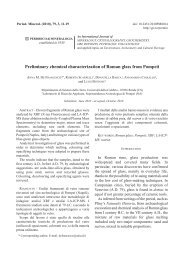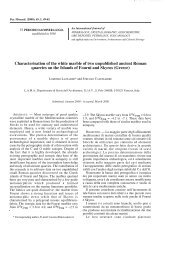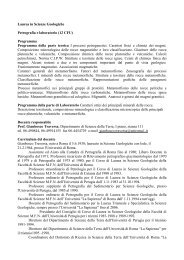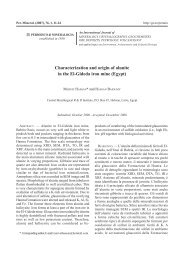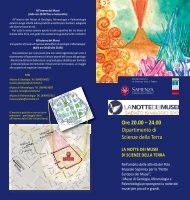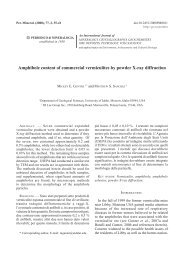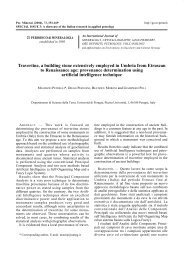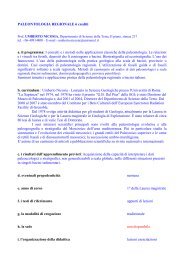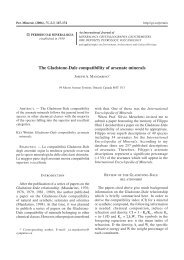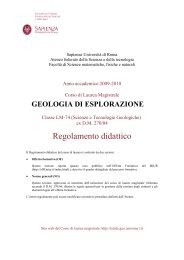Full text - Dipartimento di Scienze della Terra - Sapienza
Full text - Dipartimento di Scienze della Terra - Sapienza
Full text - Dipartimento di Scienze della Terra - Sapienza
- No tags were found...
You also want an ePaper? Increase the reach of your titles
YUMPU automatically turns print PDFs into web optimized ePapers that Google loves.
262 M.R. GHIARA, C. PETTI and P. MORBIDELLI<br />
The most information, moreover, is restricted<br />
to N a and K elements and to leucite into<br />
analcime transformation, whereas a large<br />
quantity of data concerning the mechanisms<br />
and the control of the zeolitization process and<br />
the fluid/solid interaction in closed and in<br />
simulated open systems on <strong>di</strong>fferent rock-types<br />
is available (Holler and Wirsching, 1978;<br />
Hawkins, 1981; Wirsching, 1981; Barth<br />
Wirsching and Holler, 1989; Franco et al.,<br />
1989-90; Ghiara et al., 1993, 1994; Ghiara and<br />
Petti, 1996).<br />
The lack of data on geochemical variations<br />
connected to alterations is, of course, a crucial<br />
problem in petrogenetic modelling which is<br />
only based on the behaviour of major and trace<br />
elements. Moreover, it is to be noted that the<br />
glass alteration is not always easily<br />
recognizable in thin section and so apparently<br />
fresh samples may have experienced minor<br />
alteration. Therefore, accurate X-ray stu<strong>di</strong>es are<br />
required to find out about the presence or<br />
absence of secondary minerals.<br />
A suitable way to define geochemical<br />
balances is to study coeval and<br />
petrographically comparable rocks with<br />
<strong>di</strong>fferent degrees of analcimization.<br />
A good opportunity is given by scoria cones<br />
belonging to fourth cycle of Phlegraean<br />
volcanism (Di Girolamo et al., 1984). With this<br />
objective in mind, we have undertaken a<br />
detailed petrological and geochemical study of<br />
several monogenetic scoria cones which have<br />
been extensively sampled.<br />
In this paper we report geochemical<br />
variations observed in petrographically<br />
comparable glassy and scoriaceous fragments<br />
which have experienced <strong>di</strong>fferent<br />
analcimization degrees and coming from the<br />
recent scoria cone of Fondo Riccio.<br />
The present study will hopefully shed a light<br />
on:<br />
1) post-depositional alteration of the glassy<br />
matrix lea<strong>di</strong>ng to analcime crystallization;<br />
2) geochemical changes of major and trace<br />
elements occurring in the analcimization<br />
process.<br />
GEOLOGICAL SETTING<br />
The Phlegraean Fields, located in the<br />
Neapolitan Region (southern Italy), are a<br />
Quaternary and historically active volcanic<br />
area. The last eruption occurred (Monte<br />
Nuovo) in 1538 and now the area shows<br />
fumarolic and hydrothermal activity. The<br />
oldest products (Torre Franco Tuff) are about<br />
42,000 years old (Alessio et al., 1976;<br />
Cassignol and Gillot, 1982).<br />
From a volcanological point of view, the<br />
Phlegraean Fields are mainly made up of<br />
volcanoclastic deposits, often related to<br />
phreatomagmatic eruption, minor lava flows<br />
and domes (Di Girolamo et al., 1984).<br />
Quaternary volcanic products of the<br />
Phlegraean Fields belong to the shoshonitic<br />
series of the Roman province where more or<br />
less evolved rocks (e.g. trachytes and minor<br />
phonolites) predominate over mafic or<br />
interme<strong>di</strong>ate ones (shoshonitic basalts and<br />
latites) (Di Girolamo et al., 1984).<br />
Aphyric to subaphyric Phlegraean rocks are<br />
chiefly composed of a glassy matrix with<br />
scattered few phenocrysts (Ghiara et al., 1979;<br />
Armienti et al., 1983; Di Girolamo et al.,<br />
1984 ). Post-depositional alteration, inclu<strong>di</strong>ng<br />
zeolites (e.g. analcime) as alteration products<br />
of glassy matrix, adularia and albite,<br />
overgrowths on primary sani<strong>di</strong>ne laths, have<br />
been frequently observed. Other secondary<br />
minerals are: fluorite and, to a lesser extent,<br />
calcite, epidote and hematite (Armienti et al.,<br />
1983; Beccaluva et al., 1991).<br />
MATERIALS AND METHODS<br />
Scoriaceous fragments from pyroclastic fall<br />
deposits belonging to Minopoli, Fondo Riccio,<br />
Concola, S. Teresa, Senga, and Monte Nuovo<br />
volcanoes (Ghiara et al., 1977; Ghiara, 1989-<br />
90) were sampled along vertical sections. From<br />
a volcanological point of view, these volcanic<br />
centres are monogenetic scoria cones produced<br />
by a strombolian-like volcanic activity.<br />
Pyroclastic deposits consist of rather poorly



